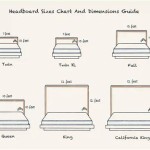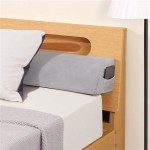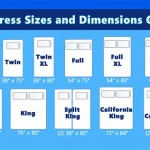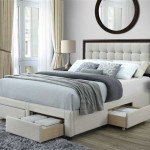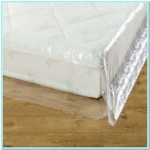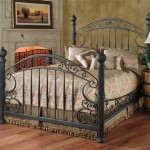Floor King Size Bed Frame: A Comprehensive Guide
A floor king size bed frame, as the name suggests, is a bed frame designed to accommodate a king-size mattress that sits directly on or very close to the floor. This style eliminates the traditional height provided by standard bed frames, offering a low-profile aesthetic that can be both modern and minimalist. The selection of a floor king size bed frame requires careful consideration of several factors, including material, design, support structure, and overall suitability for individual needs and preferences.
These bed frames are becoming increasingly popular due to their space-saving qualities and distinct visual appeal. They can make smaller rooms appear larger by maximizing vertical space and creating a sense of openness. However, potential buyers should be aware of the advantages and disadvantages associated with this type of bed frame before making a purchase. Understanding the various options available and the implications for comfort, health, and maintenance is crucial for a satisfactory long-term investment.
Key Considerations Before Purchasing a Floor King Size Bed Frame
Before committing to a floor king size bed frame, it is essential to evaluate personal needs and consider the specific characteristics of the room where the bed will be placed. Ignoring these factors can lead to dissatisfaction with the purchase and potentially negatively impact sleep quality and overall well-being.
One critical aspect is the level of support provided by the frame. A king-size mattress is substantial in size and weight, requiring a robust and well-designed frame to prevent sagging and ensure proper weight distribution. Insufficient support can lead to premature mattress wear and discomfort for the sleeper. Therefore, the materials used and the structural design of the frame should be carefully examined.
Another key point is the potential for moisture build-up beneath the mattress. Since the mattress is close to the floor, air circulation is limited, which can create an environment conducive to mold and mildew growth. This is particularly relevant in humid climates or rooms with poor ventilation. Utilizing a frame with some minimal elevation or incorporating breathable materials can help mitigate this issue.
Accessibility and ease of getting in and out of bed are also considerations, especially for individuals with mobility issues. The low profile of a floor bed may not be suitable for everyone, and it is important to assess personal physical limitations before making a decision. Additionally, cleaning under the bed can be more challenging compared to traditional bed frames with higher clearance.
Types of Floor King Size Bed Frames and Their Features
Floor king size bed frames are available in a variety of materials and designs, each offering unique aesthetic and functional characteristics. Understanding the different types can help potential buyers narrow down their choices based on their specific requirements and preferences.
Platform Floor Beds: These are perhaps the most common type of floor bed frame. They typically consist of a solid or slatted platform that sits directly on the floor or with minimal legs. Platform beds offer excellent support and are often made from wood, metal, or a combination of both. The slatted design promotes air circulation, reducing the risk of moisture build-up. Solid platforms provide maximum support but may restrict airflow.
Japanese Style Floor Beds: Inspired by traditional Japanese futon setups, these bed frames are characterized by their minimalist design and clean lines. They often feature a low platform with a recessed area to accommodate the mattress. Materials commonly used include natural wood such as bamboo or cedar, emphasizing a natural and Zen-like aesthetic. These beds often prioritize simplicity and functionality.
Upholstered Floor Beds: For those seeking a softer and more luxurious feel, upholstered floor beds are a viable option. These frames are covered in fabric, such as velvet, linen, or leather, providing a cushioned surface around the mattress. Upholstered beds can add a touch of elegance and comfort to the bedroom. However, it is important to consider the ease of cleaning and maintenance, as fabric can be more susceptible to stains and wear than other materials.
Metal Floor Beds: Metal floor bed frames offer durability and a modern aesthetic. These frames are often constructed from steel or iron and can feature a variety of designs, from simple minimalist frames to more elaborate wrought iron styles. Metal frames are generally easy to clean and maintain, making them a practical choice for many homeowners. However, they may not provide the same level of warmth and comfort as wooden or upholstered frames.
DIY Floor Beds: For the resourceful and creative individuals, building a DIY floor bed frame can be a cost-effective and personalized option. Using readily available materials such as lumber or pallets, a custom-designed frame can be created to perfectly fit the room's dimensions and aesthetic preferences. While DIY options offer a high degree of customization, it is crucial to ensure that the frame is structurally sound and provides adequate support for the mattress.
Factors Influencing the Choice of Material
The material used in the construction of a floor king size bed frame significantly impacts its durability, aesthetics, and overall performance. Therefore, careful consideration should be given to the properties of different materials before making a purchase.
Wood: Wood is a popular choice for bed frames due to its natural beauty, versatility, and durability. Different types of wood offer varying levels of hardness, grain patterns, and resistance to wear. Hardwoods such as oak, maple, and walnut are known for their strength and longevity, while softwoods such as pine and cedar are more affordable but may be less resistant to scratches and dents. Wood bed frames can be stained, painted, or left natural to complement a wide range of interior design styles. Their organic feel adds warmth and character to the bedroom.
Metal: Metal bed frames are valued for their strength, stability, and modern aesthetic. Steel and iron are commonly used materials, offering excellent support for heavy mattresses. Metal frames are typically powder-coated or painted to prevent rust and corrosion. They are available in a variety of finishes, from sleek and minimalist black to more ornate and decorative designs. Metal frames are generally easy to clean and maintain, making them a practical choice for busy households.
Upholstery: Upholstered bed frames offer a touch of luxury and comfort. Fabric options include velvet, linen, leather, and various synthetic materials. Upholstery can add texture and color to the bedroom, creating a cozy and inviting atmosphere. However, it is important to consider the durability and cleanability of the fabric. Some fabrics are more resistant to stains and wear than others. Regular cleaning and maintenance are necessary to keep upholstered bed frames looking their best.
Sustainable Materials: Increasingly, consumers are seeking eco-friendly options for their home furnishings. Bed frames made from sustainable materials such as bamboo, reclaimed wood, or recycled metal are becoming more widely available. These materials offer a lower environmental impact compared to traditional options. Bamboo is a rapidly renewable resource known for its strength and durability. Reclaimed wood adds character and history to the bedroom. Recycled metal reduces waste and conserves natural resources.
Ultimately, the choice of material depends on individual preferences, budget constraints, and aesthetic goals. Considering the properties and characteristics of each material is essential for making an informed decision that will ensure long-term satisfaction with the purchase.
Impact on Health and Well-being
The choice of a floor king size bed frame can have a significant impact on health and well-being. While offering a modern and minimalist aesthetic, it is important to consider potential health implications, especially concerning allergies and musculoskeletal health.
Allergies and Respiratory Issues: Dust and allergens tend to accumulate on the floor, and a mattress placed directly on the floor can act as a magnet for these particles. This can exacerbate allergies and respiratory problems, especially for individuals who are sensitive to dust mites, mold, or pollen. Regular cleaning and vacuuming are essential to minimize allergen build-up. Using a mattress protector and regularly washing bedding can also help reduce exposure to allergens.
Mold and Mildew Growth: As previously mentioned, limited air circulation beneath the mattress can create an environment conducive to mold and mildew growth, particularly in humid climates. Mold and mildew can trigger allergies, respiratory problems, and other health issues. Ensuring proper ventilation and using a breathable mattress can help prevent moisture build-up. Regularly inspecting the mattress and frame for signs of mold or mildew is also crucial.
Musculoskeletal Health: The low profile of a floor bed may not be suitable for individuals with back pain, arthritis, or other musculoskeletal conditions. Getting in and out of bed can be more challenging, potentially exacerbating pain and discomfort. Individuals with mobility issues should carefully consider their physical limitations before choosing a floor bed. A slightly elevated platform or the addition of assistive devices such as bed rails may be necessary to improve accessibility and reduce strain on joints.
Proper Support and Alignment: Ensuring adequate mattress support is crucial for maintaining proper spinal alignment and preventing back pain. A floor bed frame should provide a solid and stable foundation for the mattress, preventing sagging and ensuring even weight distribution. Choosing a mattress that is appropriate for individual sleep preferences and body type is also essential for optimal comfort and support. Consulting with a healthcare professional or sleep specialist can provide valuable guidance on selecting the right mattress and bed frame for individual needs.
In conclusion, while floor king size bed frames offer a stylish and space-saving option, it is important to carefully consider the potential health implications and take steps to mitigate any risks. Prioritizing cleanliness, ventilation, and proper support is essential for maintaining health and well-being.

Japanese Style Natural King Floor Bed Homary

King Size Luxury Upholstered Platform Bed Velvet Thick Headboard Floor Frame With Oversized Padded Backrest Comfort Base No Box Spring Needed Beige Wal Com
Tatami Bed Floor Frame 1 8x2 M Be In Form Only Bedroom

Japanese Style King Low Bed Frame Solid Wood Floor In Walnut

Harrison Teak Bed Frame King

Rico Low Floor Bed King Size Honey Finish At 32 Off Wooden Street

Floor Bed For Wedding Gift Weave White Oak Frame Wood Couple King Home Decor Platform Etsy
1 Floating Low Platform Queen King Bed Frame

Morgan Wingback Bedframe 5ft Kingsize Cream Plush Velvet Heavenlybeds

Clearance Alice Bed Frame King Size Floor Model

